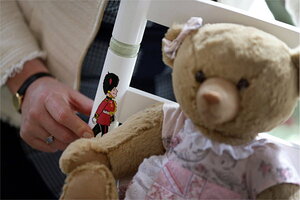Kate Middleton's royal baby might be worth $400 million (to the British economy)
Royal baby booties, sleepsuits, and other royally adorable products could add up to big business for private retailers as well as the Royal Collection Trust.

Lucinda Croft, the managing director of Dragons, a small British family business that was also tapped to design nurseries for British royals, showcases details of a hotel nursery suite at a central London hotel. The impending arrival of the royal baby has sparked a shopping frenzy that could bump the British economy almost $400 million.
Lefteris Pitarakis / AP
London
From Union Jack booties to "Born to Rule" sleepwear, the British royal family has joined retailers in offering baby products to mark the arrival of the royal heir.
Analysts estimate the baby fever could boost the economy by 240 million pounds ($380 million).
A baby sleepsuit modeled on a guardsman's outfit is one of the gifts on sale at palace shops by the Royal Collection Trust, which uses all profits for the upkeep of the royal palaces.
Prince Charles, the grandfather-to-be, is selling handmade baby shoes through a shop on his country estate Highgrove, while the mother-to-be's parents, Carole and Michael Middleton, have added a range of baby goods to their party goods business.
Joshua Bamfield, director of the Centre for Retail Research (CRR), estimated that the arrival of the baby, due in July, could add more than 240 million pounds to the British economy.
"This is a good news story and there really is no downside. With the birth coming in July, people will have time to get involved, and that means additional spending," Bamfield told Reuters after the release of the CRR's report on Monday.
"There has been a lot of interest across the Atlantic as well, as the younger royals are very well thought of in the United States, so we are expecting good sales of souvenirs."
The birth of the royal baby, who will be third in line to the throne after Prince Charles and Prince William, is the latest in a run of royal and sporting events.
Prince William married Kate Middleton in April 2011 and Queen Elizabeth marked her Diamond Jubilee in June last year. The London Olympics last summer added to the buzz.
Richard Cope, trends director at market researcher Mintel, expected the duke and duchess's baby to have a positive impact on consumer spending, which only ticked up 0.1 percent between January-March this year.
"I think the biggest commercial opportunity is going to be with tourists," Cope told Reuters, pointing to a 13 percent rise in tourists arrivals in April.
Bamfield forecast 4.8 million people would splash out 62 million pounds on alcohol to wet the future monarch's head and spend 25 million pounds on food for baby parties.
He expected 156 million pounds to be spent on commemorative china and other collectables, toys, books, DVDs and media.
Bamfield said another knock-on effect of the birth would be sales of baby products as other new parents copied the duchess.
The "Kate-effect" is already well known as sales of anything the duchess wears or uses soars. A Dalmatian coat she wore last week to launch a new cruise ship sold out within an hour.
"One of the biggest factors will be the unintentional royal brand endorsement," said Bamfield.
"The ‘Kate effect' has already taken the fashion world by storm...and this trend will follow for the infant's baby grows, rattles, first bike and so on."
(Editing by Raissa Kasolowsky)

